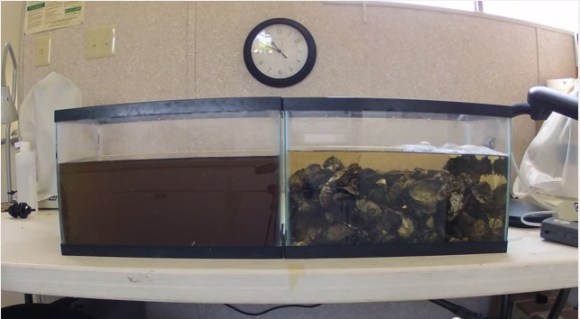
You may be familiar with oysters as the delicious seafood best eaten raw (or as ice cream) and served in months ending in “r,” but did you also know the little guys have impressive filtering skills that can clean even the dirtiest water?
Eating its fill of plankton and other particles floating around, a fully grown oyster can filter more than 50 gallons (189 liters) of seawater in one day. After seeing a few videos demonstrating this cleaning ability, some Japanese netizens started to question just how appetizing this made the once delicious-looking oyster.
In the video posted by a U.S. environmental advocacy group, two tanks of dirty water are placed right next to each other with the only difference being that one is filled with oysters. About two hours pass in the short time-lapse video and the oyster-filled tank looks practically clear by the end.
As you can see it dramatically displayed in the video above, the humble oyster does a pretty amazing job of keeping bodies of water clean (and arguably better than NASA-designed water bottles). And for most of history, natural oyster beds have been keeping water clean all over the world. Check out another video showing a group of oysters at work.
Unfortunately over-harvesting, disease and pollution have taken their toll on oysters all over the world, leaving nature’s water filter at less than one percent of its historical population. And after seeing these videos, Japanese netizens came to realize just how important the oyster is to marine ecosystems. But after pondering the oyster’s role in keeping our oceans clean, viewers began to worry about a different pressing issue: isn’t it a little disgusting to be eating something that has been sucking in all that junk from the ocean?
▼Who cares if oysters have been filter waste from the ocean if you can grill them wrapped in delicious bacon?

A lot of commenters pointed out that while this was great news for cleaning up our oceans, this was bad news for any oyster lover who would be turned off the shellfish after seeing videos of them filtering water so effectively. Some concerned oyster lovers said they would be making sure from now on exactly where their next round of delicious oysters come from and whether or not they were living in polluted waters. And a few commented that eating oysters was no more disgusting then eating liver as it is an organ in an animal’s body that also acts as a filter.
At the end of the day, with the dismal state of some of the world’s water, such as Tokyo Bay’s unfortunate tendency to turn red in the summer months, hopefully our friend the oyster can help us in getting that natural balance back. In the mean time, double-check where your oyster is coming from and say thanks to the hardworking shellfish before you douse him in lemon and sherry vinegar sauce.
Feature Image: YouTube (Florida Oceanographic)
Source: Karapia, National Oceanic Atmospheric Administration

 Japan may add Japanese language proficiency, lifestyle classes to permanent foreign resident requirements
Japan may add Japanese language proficiency, lifestyle classes to permanent foreign resident requirements Lacquerware supplier to emperor of Japan and Pokémon team up for new tableware
Lacquerware supplier to emperor of Japan and Pokémon team up for new tableware Starbucks Japan releases new zodiac chilled cup drink for 2026
Starbucks Japan releases new zodiac chilled cup drink for 2026 Merry Christmas from SoraNews24!
Merry Christmas from SoraNews24! Spirited Away’s radish spirit dances as new Bubblebody figure from Studio Ghibli
Spirited Away’s radish spirit dances as new Bubblebody figure from Studio Ghibli Japan may add Japanese language proficiency, lifestyle classes to permanent foreign resident requirements
Japan may add Japanese language proficiency, lifestyle classes to permanent foreign resident requirements Lacquerware supplier to emperor of Japan and Pokémon team up for new tableware
Lacquerware supplier to emperor of Japan and Pokémon team up for new tableware Starbucks Japan releases new zodiac chilled cup drink for 2026
Starbucks Japan releases new zodiac chilled cup drink for 2026 Merry Christmas from SoraNews24!
Merry Christmas from SoraNews24! Spirited Away’s radish spirit dances as new Bubblebody figure from Studio Ghibli
Spirited Away’s radish spirit dances as new Bubblebody figure from Studio Ghibli Step into Japanese culture with Converse’s new Japan-exclusive shoes featuring gods, sushi style
Step into Japanese culture with Converse’s new Japan-exclusive shoes featuring gods, sushi style A Japanese dating app matched our bachelorette with a Buddhist monk, and she learned some things
A Japanese dating app matched our bachelorette with a Buddhist monk, and she learned some things Drunk cycling can result in an instantly suspended driver’s license in Japan
Drunk cycling can result in an instantly suspended driver’s license in Japan Nintendo’s Kirby now delivering orders at Kura Sushi restaurants, but not in Japan
Nintendo’s Kirby now delivering orders at Kura Sushi restaurants, but not in Japan Black Thunder chocolate-bar-shaped fishing lures coming next year
Black Thunder chocolate-bar-shaped fishing lures coming next year 7-Eleven Japan starts new temporary luggage storage service in over 300 branches
7-Eleven Japan starts new temporary luggage storage service in over 300 branches Starbucks teams up with 166-year-old Kyoto doll maker for Year of the Horse decorations【Photos】
Starbucks teams up with 166-year-old Kyoto doll maker for Year of the Horse decorations【Photos】 Tokyo’s Tsukiji sushi neighborhood asks tour groups to stay away for the rest of the month
Tokyo’s Tsukiji sushi neighborhood asks tour groups to stay away for the rest of the month Disillusionment at Tsukiji’s tourist-target prices led us to a great ramen restaurant in Tokyo
Disillusionment at Tsukiji’s tourist-target prices led us to a great ramen restaurant in Tokyo Street Fighter Hadouken Churros to be launched and eaten in Tokyo, Okami pudding on offer too
Street Fighter Hadouken Churros to be launched and eaten in Tokyo, Okami pudding on offer too Japanese woman mistaken for bear
Japanese woman mistaken for bear Return of Totoro sequel short anime announced for Ghibli Park
Return of Totoro sequel short anime announced for Ghibli Park Is this the most relaxing Starbucks in Japan?
Is this the most relaxing Starbucks in Japan? Starbucks on a Shinkansen bullet train platform: 6 tips for using the automated store in Japan
Starbucks on a Shinkansen bullet train platform: 6 tips for using the automated store in Japan Japan’s human washing machines will go on sale to general public, demos to be held in Tokyo
Japan’s human washing machines will go on sale to general public, demos to be held in Tokyo Japanese train company is letting fans buy its actual ticket gates for their homes
Japanese train company is letting fans buy its actual ticket gates for their homes Is China’s don’t-go-to-Japan warning affecting tourist crowds in Tokyo’s Asakusa neighborhood?
Is China’s don’t-go-to-Japan warning affecting tourist crowds in Tokyo’s Asakusa neighborhood? Starbucks Japan unveils new Christmas goods and a rhinestone tumbler that costs 19,500 yen
Starbucks Japan unveils new Christmas goods and a rhinestone tumbler that costs 19,500 yen Tokyo considering law requiring more trash cans following litter increase in heavily touristed area
Tokyo considering law requiring more trash cans following litter increase in heavily touristed area Tokyo event lets you travel back in time, for free, to celebrate 100 years since Showa era start
Tokyo event lets you travel back in time, for free, to celebrate 100 years since Showa era start Survey asks foreign tourists what bothered them in Japan, more than half gave same answer
Survey asks foreign tourists what bothered them in Japan, more than half gave same answer Japan’s deadliest food claims more victims, but why do people keep eating it for New Year’s?
Japan’s deadliest food claims more victims, but why do people keep eating it for New Year’s? We deeply regret going into this tunnel on our walk in the mountains of Japan
We deeply regret going into this tunnel on our walk in the mountains of Japan Studio Ghibli releases Kodama forest spirits from Princess Mononoke to light up your home
Studio Ghibli releases Kodama forest spirits from Princess Mononoke to light up your home Major Japanese hotel chain says reservations via overseas booking sites may not be valid
Major Japanese hotel chain says reservations via overseas booking sites may not be valid Put sesame oil in your coffee? Japanese maker says it’s the best way to start your day【Taste test】
Put sesame oil in your coffee? Japanese maker says it’s the best way to start your day【Taste test】 The top 10 annoying foreign tourist behaviors on trains, as chosen by Japanese people【Survey】
The top 10 annoying foreign tourist behaviors on trains, as chosen by Japanese people【Survey】 No more using real katana for tourism activities, Japan’s National Police Agency says
No more using real katana for tourism activities, Japan’s National Police Agency says Starbucks Japan reveals new sakura drinkware collection, inspired by evening cherry blossoms
Starbucks Japan reveals new sakura drinkware collection, inspired by evening cherry blossoms Step into Japanese culture with Converse’s new Japan-exclusive shoes featuring gods, sushi style
Step into Japanese culture with Converse’s new Japan-exclusive shoes featuring gods, sushi style A Japanese dating app matched our bachelorette with a Buddhist monk, and she learned some things
A Japanese dating app matched our bachelorette with a Buddhist monk, and she learned some things Drunk cycling can result in an instantly suspended driver’s license in Japan
Drunk cycling can result in an instantly suspended driver’s license in Japan Nintendo’s Kirby now delivering orders at Kura Sushi restaurants, but not in Japan
Nintendo’s Kirby now delivering orders at Kura Sushi restaurants, but not in Japan Black Thunder chocolate-bar-shaped fishing lures coming next year
Black Thunder chocolate-bar-shaped fishing lures coming next year Usher good luck into your home this New Year with Totoro tenugui from Studio Ghibli
Usher good luck into your home this New Year with Totoro tenugui from Studio Ghibli Disillusionment at Tsukiji’s tourist-target prices led us to a great ramen restaurant in Tokyo
Disillusionment at Tsukiji’s tourist-target prices led us to a great ramen restaurant in Tokyo Why are there so many reincarnation and villainess anime and manga? Manga editor explains
Why are there so many reincarnation and villainess anime and manga? Manga editor explains Final Fantasy XIV x Isetan collection includes moogle soap, job bracelets, and crystal candy
Final Fantasy XIV x Isetan collection includes moogle soap, job bracelets, and crystal candy Get a taste of paradise at Japan’s top 8 ocean view cafes
Get a taste of paradise at Japan’s top 8 ocean view cafes
Leave a Reply